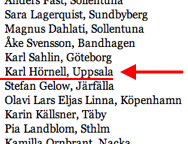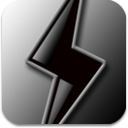 |
Multiplayer Speedoku: History
|
 |
Around the popularity peak of sudoku puzzles, the newspaper
Svenska Dagbladet organized a Swedish Sudoku Championship
in 2005 and 2006. A couple of
qualifier competitions
were first held to select the finalists.
 |
| I was just one among 310 people to continue from the first qualifier to
the second, and didn't go any further from there. |
In 2005 the qualifiers consisted simply of solving as many as possible of a set of puzzles
online within a given amount of time. There were no safeguards against cheating.
The contestants were assumed to be honest, as the finals would be live and supervised,
and there would be no point in going up against the other finalists unless you had
actual skills. But it was hard to shake off the suspicion that some of the players who
were pretty good to begin with may have given themselves a slight advantage in order
to secure a place in the finals.
Perhaps for this reason, the 2006 championship qualifier used a highly different
approach. Instead of competing individually at their own speed, players were assigned
into groups of up to four people, who had to work simultaneously on the same puzzle.
Fill in a digit correctly and get one point. Get it wrong and lose two points.
With such a collaborative effort, a board would typically get solved in about a minute.
This eliminated the most obvious way to cheat, because there just wasn't enough time
to type the numbers into an automated sudoku solver. As soon as a board was solved,
the people would be assigned into new groups, and their scoring positions (first, second,
third or fourth) would get accumulated to their total tournament scores.
The software used was a Flash-based game that I couldn't find any mobile equivalent
of, so eventually I decided to write my own. The first step was to go through a lot
of single-player sudoku apps, to find the best solutions for the user interface. Too many
mobile sudoku games (or ones on the web, for that matter) don't put enough thought into
how to input digits, resulting in games that may look good, but that you get tired of
after playing just once.
My personal favorite is having the digit keys arranged in a single line just below
the board, but then you have to move your finger a lot. That's not optimized for speed
and may prove frustrating in the long run. I decided to make this part customizable,
with four different options. (In this demo Java applet you can also use the number
keys on the keyboard, because ... well, why not?)
 So far (a little over a month after its
release), Multiplayer Speedoku has not yet taken off. Not enough people have downloaded the game, or
tried to go online, for there to be anyone to play against most of the time.
I constructed this web demo in an attempt to attract more attention to the app,
because if it can reach a critical mass of users, I think it has really interesting potential.
So far (a little over a month after its
release), Multiplayer Speedoku has not yet taken off. Not enough people have downloaded the game, or
tried to go online, for there to be anyone to play against most of the time.
I constructed this web demo in an attempt to attract more attention to the app,
because if it can reach a critical mass of users, I think it has really interesting potential.
|





|





